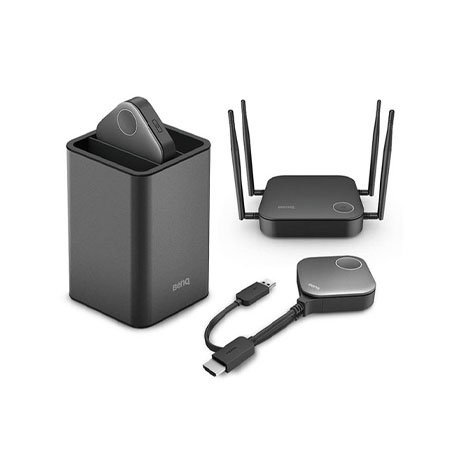How Wireless Presentation and Projectors Make Social Distancing Easier for Safer Offices
- 2020-11-30

We know. If you had a dollar for every time someone said “the world has changed in 2020”, buying an entirely new office wouldn’t be hard. But it’s just true. Things have changed and businesses and organizations of all varieties and sizes need to adapt. COVID-19, changes in the social landscape of humanity, and many other factors mean we should look at offices and meetings in an almost radically different manner.
As we mentioned before, at least the constant of good technology is still with us. And it’s getting better. Tech offers many solutions and saves for the volatile reality we find ourselves in, providing everyone from home offices through SMBs to large corporations with tools to meet the challenges of 2020 and beyond. The much talked about new normal doesn’t have to entail compromised productivity or teams of lonely employees isolated from one another. There exist many fixes and “hacks” for overcoming these hurdles, one of the most useful ones having to do with turning your office projectors into smart, wireless devices.
Can You Really Keep Six Feet Apart at Meetings?
That’s where the wireless-enabled projector steps in to help. As a focal point of meeting rooms, projectors invariably become hotspots for potential infection, if that’s something you’re concerned about. With multiple team members in the same meeting room and needing to access a single projector physically, you get lots of hands touching the same cables and connectors, and thus people coming close to each other.
We don’t mean to sound anti-social, but if you want team members to maintain social distance, you need to consider removing any close quarters convergence points, like the meeting room projector. A smart and wireless projector helps do just that. Without any cost to initiative, collaboration, or innovation.
Listen, we know the concept of a meeting is counter-intuitive to the idea of “social distance”. Nobody likes this. But if you do want to reduce the risk of COVID-19 illness among your teams, then it appears social distancing of six feet between people is something to seriously consider. It won’t be easy at first, because everyone’s used to getting close at meetings, but look at the bright side. It’ll give people in your organization another sort of challenge to rise to, and it’s a good way to make the most of circumstances.
Adding Wireless to Projectors Reduces Infection Risks
That’s just common sense. Less contact points, fewer shared surfaces, longer distances between people. All add up to a majorly lower risk of catching the world’s most famous coronavirus at the time of writing.
The best part is that you already have a projector, or should we say projectors. Your meeting rooms are all set up, and you don’t need to change anything. For the best results, all you need is a smart, wireless presentation system like the BenQ InstaShow family of devices. Seamless, essentially plug n play, and super easy to use, InstaShow allows for nearly contact-less sharing, casting, and viewing of content from employee devices via a central projector without the physical contact involved in changing cables and connectors.
People don’t even need to get up from their seats, and everything’s done wirelessly so keeping six feet apart is easy. There’s no focal point to the meeting room where team members need to get close or pass by one another. There are no controls to pass around, and each employee gets their own dongle or adapter for use with their personal laptop. We know this sounds awkward and very cold, but companies that want to adhere to social distancing recommendations should seriously consider this.
Even better, the InstaShow WDC20 pairs with large-format interactive flat panels to bypass the projector altogether, resulting in an experience even closer to true touchless. The WDC20 also supports split screen modes to accommodate team members who’re calling from home. In the era of hybrid work and virtual meetings, this combination of split screen and local content mirroring addresses multiple concerns with a single device.
But even without a global pandemic and health concerns, going with wireless presentation resolves long-standing clutter issues that have plagued meetings for decades. With a wireless system you’re rescued from the hassle of figuring out which cable connects to what. More content can be quickly shared without making a fuss over it. Meetings are more productive and less prone to IT-related delays. So if you get a wireless presentation system now, you’re investing in a better future for your office even after the current crisis passes.
Consider a Standalone Smart Wireless Projector
An alternative or supplement to wireless presentation systems are projectors with smart and wireless features. Unlike traditional meeting room projectors, the new breed incorporates Wi-Fi and often Bluetooth. They have an onboard operating system, typically based on Android. You get pre-installed apps, including a browser. There’s no need for video cables, just power. This is also great for reducing physical contact, and since smart wireless projectors like the BenQ EH600 have everything you need for meetings and content mirroring already installed, there’s no reason for employees to congregate close to them. Keeping social distance is again made easier, just like with wireless presentation systems.
The EH600 is a prime example of how to do a smart wireless projector. It works with nearly every smartphone, tablet, laptop, and probably many other devices we can’t think of right now. If you must, you can plug USB drives into it, but that would increase physical contact potentially, so we recommend keeping things wireless. And all the content team members share is displayed in the usual big picture format of projectors, so there’s no need to huddle around a small screen, breathing on each other. That’s better for everyone.
You Have the Tools, Now Adapt
Don’t despair. We’ll get through this. There may be some adjustments to make in the meanwhile, but it’ll pass and people will go back to doing things the truly normal way. There’s nothing wrong with being close, but if for now we should be cautious, then that’s OK.
Thanks to the wonder of human technology, adapting is neither hard nor expensive. And it’s not in vain. These tools that’ll help you get through COVID-19 will continue to serve you faithfully long into the future, as none were specifically designed for disease prevention. They were designed for better, more efficient, more versatile work productivity, and that’s something we all want well beyond the current situation.
Recommended Articles
-
Trends & Knowledge
Tech That Helps Us Get Back to the Office Safely
2020.11.16 -
Trends & Knowledge
How Business Meetings Have Evolved
How businesses have adopted remote and hybrid working modes and how BenQ collaborative meeting rooom solutions can help
2020.10.30 -
Trends & Knowledge
Why every meeting room needs split-screen technology post COVID-19?
Modern wireless presentation systems with split-screen can make your collaboration space safer and more productive.
2020.08.21
